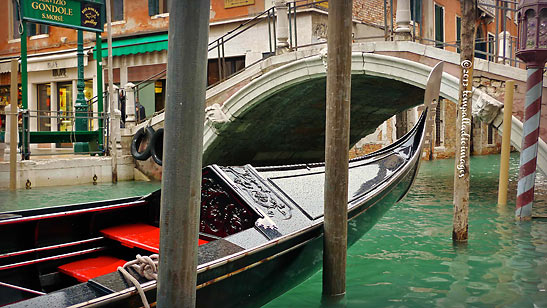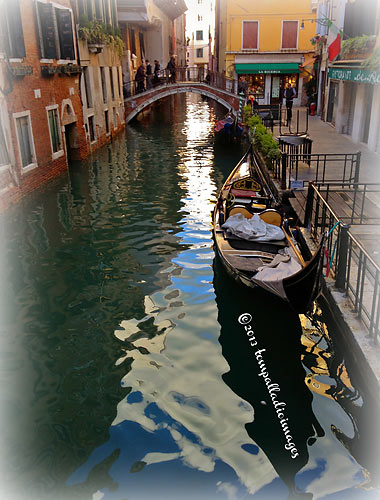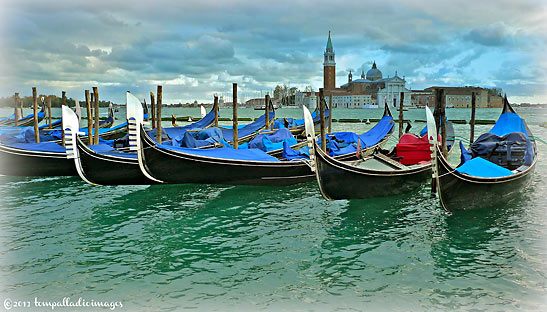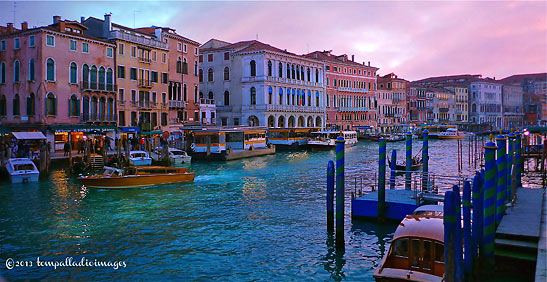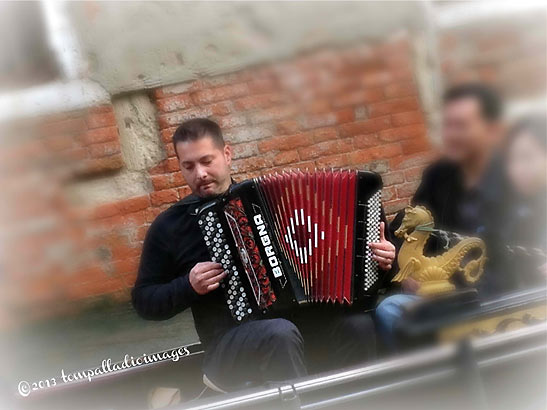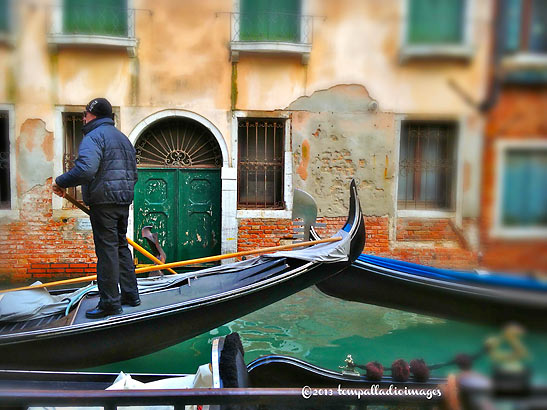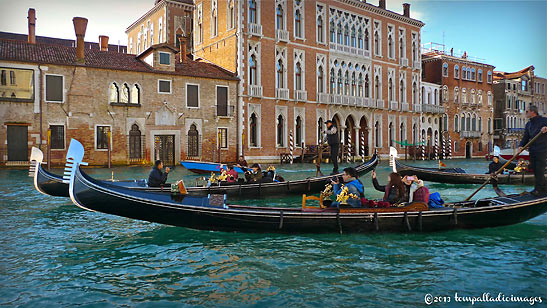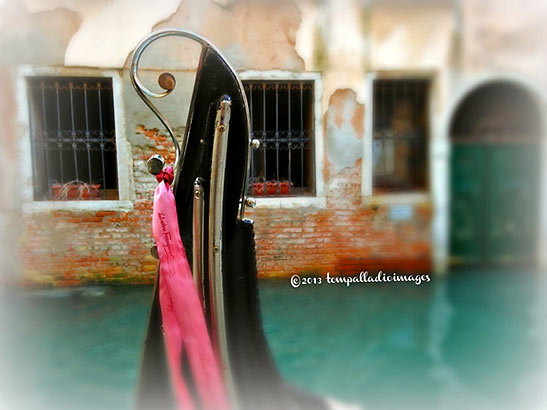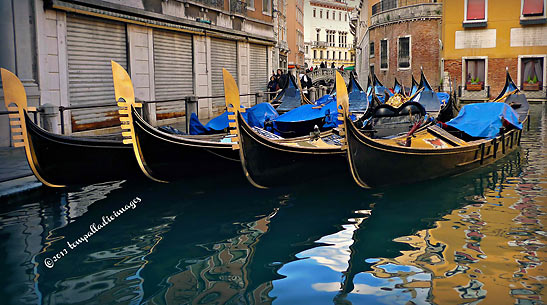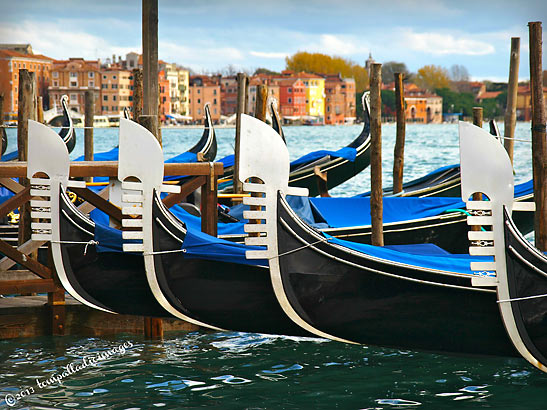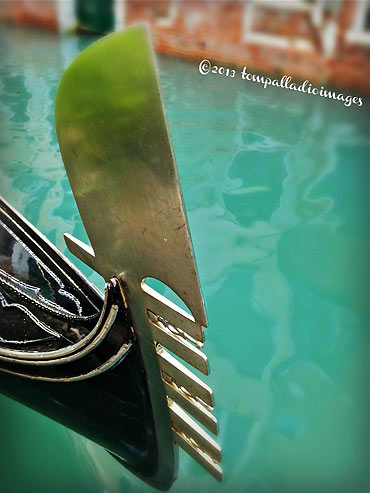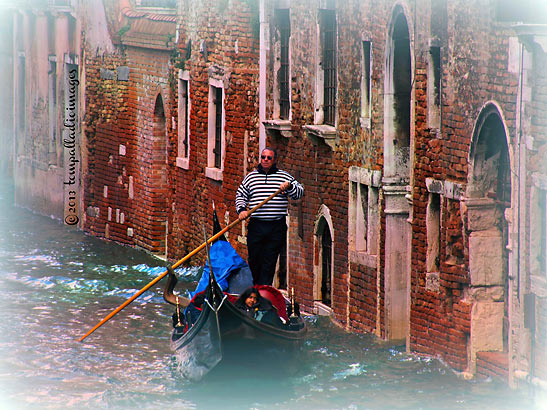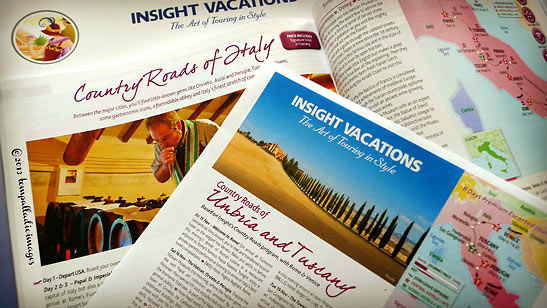 |
 |
|
 |

|
Country Roads:
Gliding into the Venetian Sunset Story and photos by Tom Weber
Too bad this bittersweet moment has to center around the gondola, but the person, or persons, who crafted the itinerary for this media-only familiarization trip, placed it at the very end. Maybe the author of the travel doc is a romantic, or perhaps a sadist. I won't ask, so we'll never know. Gliding along in one of the most iconic symbols of La Serenissima, the gondola, in the right company and under a moonlit sky, is as romantic an excursion as you'll ever experience, so I've been told. The company I'm with is fine, more like colleagues vice lovers, at least as far as I can tell. We're most interested in photographing every inch of this centuries-old flat-bottom tradition rather than holding hands, exchanging glances and stealing kisses, although, a few of my "colleagues" are pucker-up worthy (names are being withheld to protect the innocent and/or embarrassed).
If you're looking to find romance pulsating from within the lines of this blog post about the gondola, Casanova's preferred mode of transport, think again. The best I can offer is to refer you over to another, more famous travel writer: Samuel Langhorne Clemens, better known by his pen name, Mark Twain, the "father of American literature," a great humorist and, on several occasions, a travel writer of sorts via a series of letters he wrote while in Europe.
On the subject of the gondola and its influence on the romantic mood, Twain, in his 1869 book The Innocents Abroad, wrote: "...the fairy boat in which the princely cavaliers of the olden time were wont to cleave the waters of the moonlit canals and look the eloquence of love into the soft eyes of patrician beauties, while the gay gondolier in silken doublet touched his guitar and sang as only gondoliers can sing!" Like I said, I'm here to document the craft, the ride and the experience, not to provide narrative about on-board romantic interludes by lovers in love. After all, what unfolds on a gondola should remain on said gondola.
Broken down into groups of six, the maximum amount of passengers permitted on a gondola, our band of merry media, now aboard the little flotilla of shiny, ebony-black craft, sets sail from the landing and glides down the first of several canals we'll traverse, serenaded along the way by a Venetian accordion player.
Stefano, our gondoliere (gondolier) – one of only 425 in the profession licensed by the City of Venice and a card-carrying member of the Gondoliers' Guild – stands above and near the boat's tail facing forward, balanced like a tightrope walker under the big top, and rows, one gentle stroke at a time. With the aid of his nearly four meters-long heavy demo (oar) that's attached to the forcala (oar lock), which allows the oar to move in different directions and angles, Stefano maneuvers the stretch limo-on-water around traffic and through the narrowest rii and rielli (medium and small size canals) leaving a shadows-into-sunlight rippled trail behind in the quiet aqua blue water.
As you look around, you might ask yourself, why are all the gondolas painted black? The answer is simple. In the 16th century, the city fathers, in an effort to standardize the look and size of the banana-shaped water taxi moving to and fro, chose the color black because it was considered the color of elegance and not that of death – red was the color that symbolized mourning around Venice – and it covered over well the black pitch, or resin, used to seal and waterproof the gondola.
In their heyday, between the 17th and 18th centuries, gondolas navigating Venice's waterways numbered nearly 10,000. Today, that number has dwindled to about 400; all devoted entirely to tourists looking for a hired ride to carry them around picture-postcard perfect Venezia.
Gondolas, new ones handmade by expert craftsmen, cost somewhere in the neighborhood of $45,000 USD, and are composed of 280 pieces fabricated from eight different kinds of wood. Sans passengers and gondolier, the boat weighs around 350 kg, is 10.85 m long by 1.40 m wide. And, the left side of the craft, surprisingly, is a bit longer than the right side, to ensure that the gondola doesn't favor moving to the left with every row stroke by the gondolier.
The ferro (iron), the distinctive ornamentation at the prow, the most forward part of the boat, serves as the gondola's front bumper protecting it from everyday nicks and scratches and the occasional collision with other craft occupying the cramped, shared space. More than just a bumper, the ferro, next to the winged lion of St. Mark, is the most recognized symbol of the Most Serene Republic of Venice and describes in its design the City of Canals.
The metal band running down the face of the gondola has an "S" shape, representing the Grand Canal cutting its serpentine route through Venice. The group of six prongs, or teeth, jutting out of the prow, represent the six sestiere (districts) of La Serenissima: Cannaregio, Castello, Dorsoduro, San Marco, San Polo and Santa Croce. The lone prong, pointing in the opposite direction of the other six, represents the island of Giudecca, just south of Venice's main islands. The elegant curve at the top of the design represents the cap of the Doge, the leader of Venice and its most serene republic for almost 1,100 years. And, the semicircle, between the curve at the top and the prongs below it, represents Ponte Rialto (Rialto Bridge).
Close enough to touch the twilight-toned, weathered brick walls of the adjacent buildings that encase the route, we close our eyes as the accordion's melody fills the air and imagine what it must have been like centuries ago to be in this very same spot, in a gondola on a scenic little riello (small canal) in majestic La Serenissima. We wish this ride, and the watercolor-like visual and mental impressions it painted, would last forever, but it, as well as our eight-day, Insight journey, comes to a melancholic end as we quietly round the bend and glide into the Venetian sunset.
For complete information on Insight Vacations' 12 Italian premium and luxury-escorted itineraries and over 100 journeys throughout Europe, just click HERE, or call toll-free (888) 680-1241, or contact your travel agent. Arrivederci! Related Articles:
|
|
Feedback for Destination Bosnia: Inside Sarajevo's Tunnel of Hope Spent time in Sarajevo in the fall of 1973…beer was excellent! --- David * * * * Hi Tom, I must say, you're photographs are always amazing. They are top notch. You bring so much class to Traveling Boy. It's photographs like yours that make me want to go out and do my own traveling. Please don't get tired of sending us your amazing adventures. It's such a delight for the soul. --- Raoul, Whittier, CA * * * * Hi Tom: --- David * * * * Hey Tom – Wow! Love those photos – they are so super that they make me A) Want to start eating NOW. B) Go there myself. C) See all that pristine beauty that looks so restful and peaceful. Great story, superb pix!!! Bravo!! --- John, Los Angeles, CA * * * * Feedback for Destination Southwestern France: Saint-Émilion Good job, Tom, and timely info. St. Émilion is in the list of places Jim Hayes and I will visit in September 2014. If we get the chance, we will exploit your experience to enhance the trip! --- Bobby Harper, Dameron, MD * * * * Feedback for Vicenza Walks – Monte Berico I lived in Vicenza for 4 years in the U.S. ARMY from 1963 to 1967. A wonderful place to explore. Palladio’s works are amazing. Have been back twice since and find new places to visit. My favorite is MONTE BERICO where I have some wonderful photos of my family. --- Dr. Albert Pizzi, Hanover, MA * * * * I liked the new TB particularly the Vicenza article that took me back as a youth when we lived in Naples and travelled up there for a baseball tourney (U.S. Military Bases dependent schools played each other.) Took me back to the plaza. --- Bill Feedback for A Canterbury Trail (Sutri) Very interesting note. I have wedroned which route the early pre-Christian and Christian pilgrims travelled to Rome from England. Is it still possible to travel the Francigena trail? --- Pawel You can find out more info on walking tours of Via Francigena at this site: http://www.compagniadeicammini.it/en/. Thanks for stopping by and commenting.. Tom * * * * Good article, enjoyed reading it. Saved your recommended sights for future use. --- Dardenne Prairie, MO * * * * You're going to be great at this Tom. Congrats. --- Donna Vissa -Montreal
|
This site is designed and maintained by WYNK Marketing. Send all technical issues to: support@wynkmarketing.com

|






